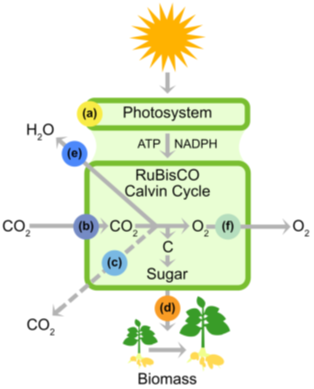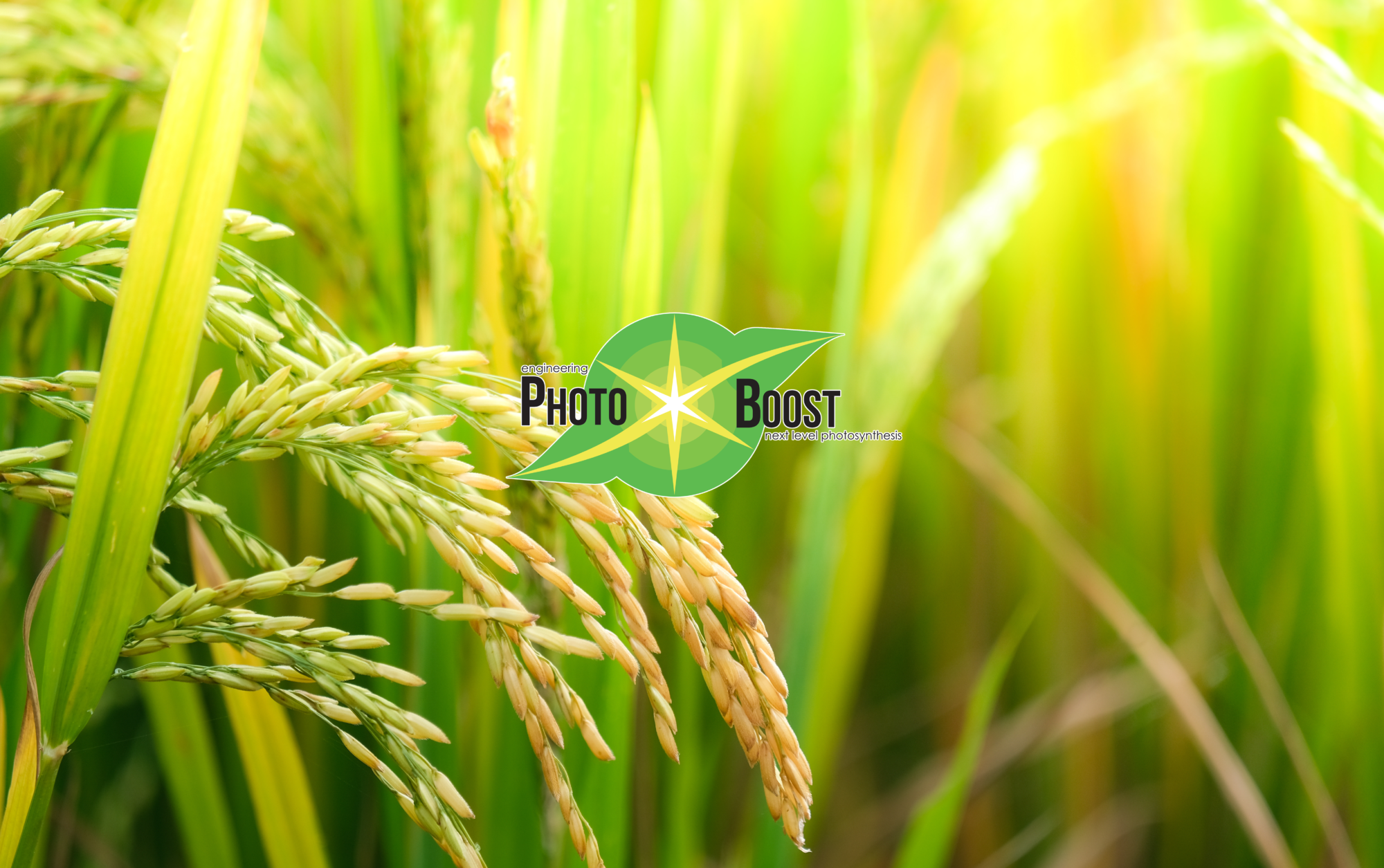Project summary
PhotoBoost is a 5-year research and innovation action that aims to significantly improve the efficiency of photosynthesis in plants. The optimisation of photosynthesis will be achieved by capitalising on multidisciplinary approaches including computational biology, metabolic modelling, systems biology, enzyme and pathway engineering, synthetic biology, and the multigene transformation of two major C3 crops: potato and rice. The PhotoBoost approach involves the creation of new strategies and the improvement of already proven strategies that increase the efficiency of photosynthesis. Six new and improved strategies will then be combined to boost photosynthetic efficiency by at least 20–25% and biomass yields by at least 25–30%. This overall aim is realistic because the project partners have already achieved up to 15% increases in photosynthetic performance by exploiting the individual strategies. The successful implementation of the PhotoBoost concept will be validated by performing greenhouse and field trials under diverse environmental conditions. The project will therefore broaden our understanding of photosynthesis, leading to novel concepts that can be used to enhance yields even further, and to increase the robustness of potato and rice crops in a changing climate. The PhotoBoost project will deliver new crops with a higher rate of biomass accumulation for commercial exploitation, facilitated by two consortium partners representing the plant breeding industry. Finally, PhotoBoost will provide industry, policymakers and consumers with the experimental evidence and social communication channels needed to facilitate the evaluation and decision-making process for the adoption of new biotechnology solutions that address current challenges in agriculture.
The overarching goal of the PhotoBoost project is to address the widening gap between agricultural productivity and the global demand for food/feed and bioenergy crops in an environmentally friendly and sustainable manner by increasing the efficiency of photosynthetic CO2 fixation in staple food crops that are economically important in Europe but also on a global scale. Our focus on staple food crops rather than model systems will accelerate the impact of the project, as discussed in more detail in the Impact section of the proposal (pp. 18-21). We will meet our goal by developing enhanced C3 crops that combine two or more of the following strategies: (a) the optimisation of light reactions during photosynthesis; (b) the integration of an algal CCM; (c) the introduction of an engineered photorespiratory bypass mechanism by expressing the bacterial glycolate dehydrogenase polyprotein (DEFp), glyoxylate carboligase (GCL) and tartronic semialdehyde reductase (TSR), improved by the knockout of the plastid glycolate–glycerate PLGG1) transporter; (d) the optimisation of source–sink capacity (only in potato) by expressing pyrophosphatase (PPase) in the mesophyll cells to enhance source capacity, as well as two plastid metabolite translocators – glucose 6-phosphate/phosphate translocator (GPT) and adenylate translocator (NTT) – in the tubers to re-route photoassimilates to the sink organs, supported by knocking out the phloem-mobile tuberisation signal SP6A to enhance the resilience of heat-sensitive cultivars; and (e) the adaptation of stomatal conductance by the introduction of a hexokinase gene, to improve water-use efficiency. In the past, the consortium members have increased photosynthetic efficiency by up to 15% using these individual strategies, but to the best of our knowledge the stacking of multiple photosynthesis-enhancing traits in the same plants has never been attempted before. We will also explore the integration of an oxygen scavenging mechanism as a novel strategy (f) to further reduce photorespiration and boost the efficiency of photosynthesis.

Illustration of the overall concept of the PhotoBoost project is to improve the photosynthetic performance of C3 plants by combining (a) the optimisation of light reactions; (b) the integration of an algal CO2 concentration mechanism; (c) an engineered photorespiratory bypass optimised by knocking out the native plastidial glycolate–glycerate transporter; (d) the optimisation of source–sink capacity improved by knocking out the phloem-mobile tuberisation signal SP6A; (e) improved water-use efficiency by adapted stomatal conductance; and (f) the integration of an O2 scavenging mechanism.
The PhotoBoost project will generate potato and rice plants with superior photosynthetic efficiency by exploring the best combinations of the strategies listed above. In quantitative terms, we aim to increase photosynthetic efficiency under diverse environmental conditions (validated by greenhouse trials under different forms of stress, or field trials in countries with diverse climates) by at least 20–25% in terms of photosynthesis rates and by at least 25–30% in terms of biomass yield. The technology readiness level (TRL) of our strategies will advance from TRL3 (current position) to TRL5–6 upon the conclusion of this 5-year project.
Specific objectives:
1. Development, refinement and application of metabolic models that simulate complex photosynthetic pathways/networks to predict the effects of proposed pathway modifications, support the selection of suitable combinations of photosynthetic enhancement strategies, and provide a rational basis for enzyme optimisation.
2. Development of a novel, photosynthetically active cell-free lysate to enable the high-throughput testing and optimisation of enzymes and transporters as well as combinations thereof involved in photosynthetic metabolism
3. Application of the CRISPR/Cas9 system to knock out (1) the native plastid glycolate–glycerate (PLGG1) transporter in the potato and rice photorespiratory pathways to further improve the photorespiratory bypass (strategy c, above); and (2) miRNA involved in the heat-mediated inhibition of SP6A to optimise the heat tolerance of potato by adapting the source–sink capacity to environmental factors.
4. Development and implementation of a novel oxygen scavenging pathway in potato and rice (strategy f, above) to enhance the CO2/O2 ratio at the RuBisCO site and limit photorespiration, thus complementing the photorespiratory bypass (WP3).
5. Generation of potato and rice plants featuring different combinations of these mechanisms (strategies a–f, above) to boost the efficiency of photosynthesis (WP3). Promising combinations will be selected based on pre-existing data generated by the consortium members and driven by the advanced metabolic models (Objective 1).
Project Structure and Timelines
Workpackages
The project is structured into seven interconnected workpackagesworkpackages
WP1: Modelling photosynthetic metabolism
WP2: Generation of a novel photosynthetically active cell-free lysate for protein testing
WP3: Stacking different strategies to improve photosynthetic efficiency in C3 plants
WP4: Greenhouse and field trials under diverse conditions
WP5: Detailed biochemical analysis
WP6: Social sciences and humanities
WP6: Management
Partner Interactions and tasks
In the context of the WPs different tasks are being addressed by the network of the different Photoboost partners as shown. (note that SGHMS has been replaced by Oxford University)

